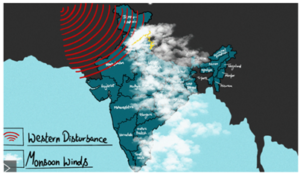Context:
The recent heavy rainfall across the entire North Indian belt has unleashed mayhem in many states.
Trend of Monsoon in 2023


News Source: The Hindu

- Delay Onset: Southwest monsoon has hit the Kerala coast on June 8, delaying significantly by 7 days.
- Normal date of the onset of the monsoon over the Kerala coast is June 1.
- Extreme rainfall event: It resulted in large-scale flooding, destruction and loss of lives.
- Heavy rainfall in Himachal Pradesh has claimed 30 lives till now.
- Financial Loss: State has also seen loss to infrastructure with an initial estimated between ₹3000 crore to ₹4000 crore.
- Landslides: According to the Himachal Pradesh emergency operation centre, fourteen major landslides and 13 flash floods have been reported in the past 36 hours while over 700 roads have been closed.
- It was caused by incessant rains that have been reported from various regions in Himalayan region.
- When heavy rains meet “undesirable, unpragmatic, unplanned structural intervention on the fragile landscape of hills”, it can cause landslides.
- Deforestation for public and private infrastructure projects leaves the soil weak and vulnerable to spate of water coming from a higher level.
- Other Factors for Landslides: Geological weakness of the soil, lack of vegetation and prolonged human pressure are the major factors for the landslide.
- Monsoon Variability: According to the India Meteorological Department (IMD), on July 9, there was 59% excess rainfall over northwest India; 4% excess over central India; 23% deficiency over peninsular India and 17% deficiency over east and northeast India.
- El Nino: It is the warming of the equatorial Pacific Ocean that impacts weather events worldwide.It is likely to develop earlier than expected and has the effect of suppressing the Indian monsoon rainfall.
- Interaction of Monsoon with Western Disturbance: According to the Indian Meteorological Department (IMD), heavy rain in parts of Himachal Pradesh and Uttarakhand is due to the interaction of the monsoonal winds with the western disturbance that has created a trough above Himachal Pradesh.

Image Source: India Today
- Cyclone: Cyclones in the North Indian Ocean have had both positive and negative impacts on the onset of the monsoon. Example: If a cyclone lies further north in the Bay of Bengal, the back-winds blowing from the southwest to the northeast can pull the monsoon trough forward, and assist in the monsoon’s onset. Mocha cyclone helped the monsoon set in on time over the Andaman and Nicobar Islands. On the other hand, Cyclone Biparjoy led to delay in the arrival of the monsoon over Mumbai by nearly two weeks.
- Orographic lifting: Some regions of India has witnessed orographic rainfall. Due to global warming, there’s extra moisture, and the hills stop this moisture flow and lift it, which comes down as heavy rains.
- Climate Change: Impact of global warming on the monsoons are manifest in the onset, withdrawal, its seasonal total rainfall, and its extremes. For Example, Global warming also affects the cyclones over the Indian Ocean and the typhoons over the northwestern Pacific Ocean. Climate change is making the seasonal rains more intense, longer lasting and more unpredictable.
- Ocean Warming: Monsoon course is affected by the three tropical oceans – Indian, Atlantic, and Pacific; the ‘atmospheric bridge’ from the Arctic; and the oceanic tunnel as well as the atmospheric bridge from the Southern Ocean.
- A ‘bridge’ refers to two faraway regions interacting in the atmosphere while a ‘tunnel’ refers to two remote oceanic regions connecting within the ocean.
- Marine heatwave in India’s eastern sea is causing extreme rain in its northwest. For Example-A warmer Bay of Bengal is likely playing a role in increasing faster timescale depressions and reducing slower timescale depressions In 2023, a warmer-than-usual Bay of Bengal has already experienced
- Unsustainable Exploitation: From the mega road expansion project in the name of national security (Char Dham Highway) to building cascading hydroelectric power projects, from unplanned expansion of towns to unsustainable tourism, the Indian States have ignored warnings about the fragile ecology.
- Adaptability: Avoiding the development of large hydroelectric projects in the sensitive area.
- Higher Himalayas are sensitive to changes in climate and tectonic activity, large hydroelectric projects should ideally not be built there or should only have a minimal capacity.
- Scientific methods for construction: All scientific methods should be used when building roads.
- At this time, slope stability, high-quality retaining walls, and rock bolting are not being used when building or widening roadways. All of these actions can limit the harm caused by landslides to some extent.
- Community Involvement in Development: Flash floods, cloudbursts, and landslides are common natural disasters in Himachal Pradesh, Uttarakhand. A halt to hydropower development has been demanded by the local populace.
- Capacity Building: Capacity and efficacy of the drainage system have to be periodically assessed and augmented by local municipality.
- Unified Effort: It is imperative for the local administration, the State Disaster Response Force and the National Disaster Response Force to work in close coordination and mitigate the devastating effect of excessive rain.
Terminology Used in Article:
Western Disturbance:
|
Post Views: 191
